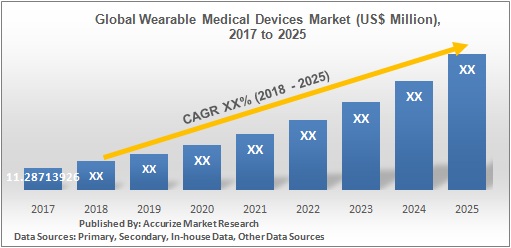Wearable Medical Devices Market Global Scenario, Market Size, Outlook, Trend and Forecast,
(2014 - 2022) and (2017 – 2025)
The global market for wearable medical devices was valued at $3.1 billion in 2014 and is expected to reach $13.5 billion by 2022. Further, the market is expected to reach $XX billion by 2025; growing at a CAGR of XX% from 2017 to 2025. Wearable technology devices form a major part of the Internet-of-Things (IoT), and are predicted to have a significant influence on the fields of fitness, medicine, disabilities, education, transportation, gaming, and entertainment. The increasing demand for industries such as remote patient monitoring devices and home healthcare is expected to propel the demand for wearable medical devices. Furthermore, increasing focus on fitness, growing awareness among the population, rise in base of the aging population, and a healthy lifestyle orientation expected to impact the Wearable Medical Device Market.
Wearable devices are small electronic products, primarily consisting of one or more sensors and having computational capability. They are inserted into devices that attach to the body, such as an individual’s head, feet, arms, wrists, and waist. They can resemble a watch, eyeglasses, clothing, contact lenses, shoes, etc. Wearable devices either capture data or present data and the types of data collected could be as simple as the number of steps taken in a day or as complex as ECG. The wearable medical devices market has grown significantly over the past few years as innovations and advancements in electronics, material sciences, and sensor technologies have allowed various startups to introduce relatively inexpensive and fashionable devices into the market.

In addition, consumer interest in personal health, growing awareness about wearable devices among the population, rise in base of an aging population, increasing benefits from wearable devices and rise in disposable income, are the factors that have helped to propel this market forward. Furthermore, increasing focus on innovations by tech start-ups and favorable government policies are also driving the market in the coming years. Along with these above-mentioned driving factors, there are some restraints which are expected to hinder the market growth in the coming years. Privacy issues, unaddressed regulatory issues, unfashionable products, technical difficulties and cost of these products are some of the restraining factors, which could hinder the market.
Based on the type of devices, the market for wearable medical devices is segmented to diagnostic and therapeutic devices. Among these, diagnostic devices further divided into Vital sign monitors, Sleep and activity monitors, Fetal and obstetric monitors, Neuro-monitoring devices, and ECG monitors. And, therapeutics devices is segmented into Pain management devices, Insulin monitoring devices, Respiratory therapy devices, and Rehabilitation devices. Based on the site of application, the market is segmented into Handheld, Headband, Strap, Shoe sensors and others.
Geographically, the market is divided into the Americas, EMEA (Europe, Middles East, and Africa), and Asia-Pacific. Asia-Pacific region is expected to display the fastest growth for wearable medical devices during the forecast period. Growing awareness among the population, increasing disposable income, and rising incidence rate of chronic diseases are few factors promoting growth in this region. Whereas, the Americas region is expected to maintain its lead throughout the forecast period, owing to the presence of a large number of players, immediate acceptance of innovative products by the consumers and increasing demand for wearable devices.
The report covers a strategic analysis of the global market for wearable medical devices, and the growth forecast for the period; 2017 – 2025. The scope of the report includes competitive analysis of various market players who are operating in the market, segmental analysis based on the type of devices and application areas. It also covers geographical analysis of the market with growth forecast for the period; 2017 – 2025. Porter’s Five Forces analysis and competitive analysis included in the report provides an insight into market dynamics and industry competition.
The study also provides information for recent merger and acquisition deals happened in the market. Moreover, the report also includes growth strategies and entry barriers to be considered to cater to the exact business opportunities in this market. Additionally, to aid in strategic decision making, the report also includes competitive profiling of leading players, recent developments in the industry, financial analysis and various business strategies adopted by them. This report will help players in global wearable medical devices market to plan and implement their strategies in different market areas such as emerging geographies, and new technologies.
The company profile section includes the detailed analysis of the key players such as Philips Electronics, Omron Corporation, Zephyr Technology Corporation, Fitbit Inc., Johnson and Johnson, The Boston Scientific Corporation, and LifeWatch AG among others.
Back to top